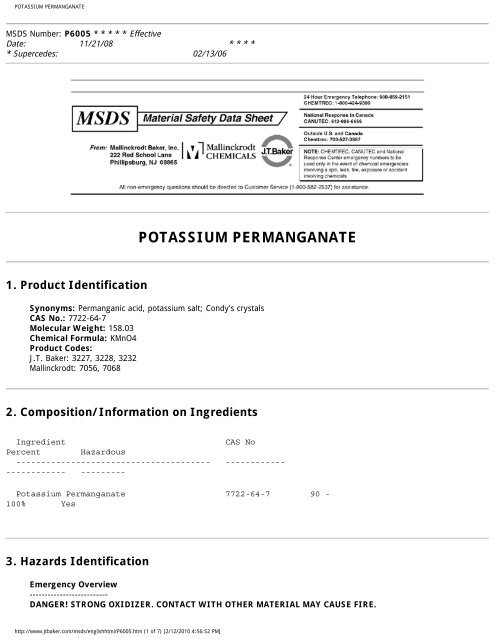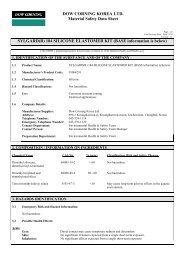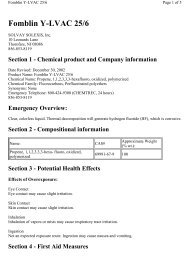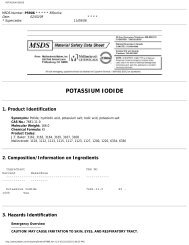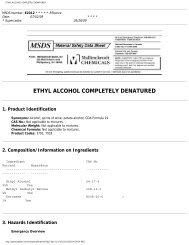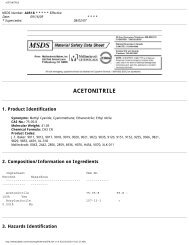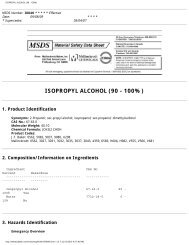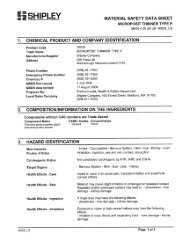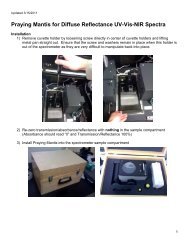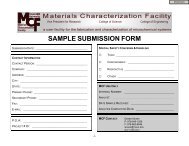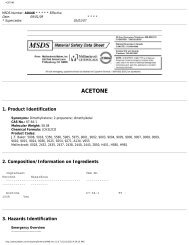POTASSIUM PERMANGANATE
POTASSIUM PERMANGANATE - Materials Characterization Facility
POTASSIUM PERMANGANATE - Materials Characterization Facility
- No tags were found...
You also want an ePaper? Increase the reach of your titles
YUMPU automatically turns print PDFs into web optimized ePapers that Google loves.
<strong>POTASSIUM</strong> <strong>PERMANGANATE</strong><br />
MSDS Number: P6005 * * * * * Effective<br />
Date: 11/21/08 * * * *<br />
* Supercedes: 02/13/06<br />
<strong>POTASSIUM</strong> <strong>PERMANGANATE</strong><br />
1. Product Identification<br />
Synonyms: Permanganic acid, potassium salt; Condy's crystals<br />
CAS No.: 7722-64-7<br />
Molecular Weight: 158.03<br />
Chemical Formula: KMnO4<br />
Product Codes:<br />
J.T. Baker: 3227, 3228, 3232<br />
Mallinckrodt: 7056, 7068<br />
2. Composition/Information on Ingredients<br />
Ingredient<br />
CAS No<br />
Percent Hazardous<br />
--------------------------------------- ------------<br />
------------ ---------<br />
Potassium Permanganate 7722-64-7 90 -<br />
100% Yes<br />
3. Hazards Identification<br />
Emergency Overview<br />
--------------------------<br />
DANGER! STRONG OXIDIZER. CONTACT WITH OTHER MATERIAL MAY CAUSE FIRE.<br />
http://www.jtbaker.com/msds/englishhtml/P6005.htm (1 of 7) [2/12/2010 4:56:52 PM]
<strong>POTASSIUM</strong> <strong>PERMANGANATE</strong><br />
CORROSIVE. CAUSES BURNS TO ANY AREA OF CONTACT. HARMFUL IF SWALLOWED OR INHALED.<br />
SAF-T-DATA (tm) Ratings (Provided here for your convenience)<br />
-----------------------------------------------------------------------------------------------------------<br />
Health Rating: 3 - Severe (Life)<br />
Flammability Rating: 0 - None<br />
Reactivity Rating: 3 - Severe (Oxidizer)<br />
Contact Rating: 3 - Severe (Corrosive)<br />
Lab Protective Equip: GOGGLES & SHIELD; LAB COAT & APRON; VENT HOOD; PROPER GLOVES<br />
Storage Color Code: Yellow (Reactive)<br />
-----------------------------------------------------------------------------------------------------------<br />
Potential Health Effects<br />
----------------------------------<br />
Inhalation:<br />
Causes irritation to the respiratory tract. Symptoms may include coughing, shortness of breath. High<br />
concentrations can cause pulmonary edema.<br />
Ingestion:<br />
Ingestion of solid or high concentrations causes severe distress of gastro-intestinal system with possible burns<br />
and edema; slow pulse; shock with fall of blood pressure. May be fatal. Ingestion of concentrations up to<br />
1% causes burning of the throat, nausea, vomiting, and abdominal pain; 2-3% causes anemia and swelling of<br />
the throat with possible suffocation; 4-5% may cause kidney damage.<br />
Skin Contact:<br />
Dry crystals and concentrated solutions are caustic causing redness, pain, severe burns, brown stains in the<br />
contact area and possible hardening of outer skin layer. Diluted solutions are only mildly irritating to the skin.<br />
Eye Contact:<br />
Eye contact with crystals (dusts) and concentrated solutions causes severe irritation, redness, blurred vision<br />
and can cause severe damage, possibly permanent.<br />
Chronic Exposure:<br />
Prolonged skin contact may cause irritation, defatting, and dermatitis. Chronic manganese poisoning can<br />
result from excessive inhalation exposure to manganese dust and involves impairment of the central<br />
nervous system. Early symptoms include sluggishness, sleepiness, and weakness in the legs. Advanced cases<br />
have shown symptoms of fixed facial expression, emotional disturbances, spastic gait, and falling.<br />
Aggravation of Pre-existing Conditions:<br />
No information found.<br />
4. First Aid Measures<br />
Inhalation:<br />
Remove to fresh air. If not breathing, give artificial respiration. If breathing is difficult, give oxygen. Get<br />
medical attention immediately.<br />
Ingestion:<br />
If swallowed, DO NOT INDUCE VOMITING. Give large quantities of water. Never give anything by mouth to<br />
an unconscious person. Get medical attention immediately.<br />
Skin Contact:<br />
Immediately flush skin with plenty of water for at least 15 minutes while removing contaminated clothing<br />
and shoes. Get medical attention immediately. Wash clothing before reuse. Thoroughly clean shoes before reuse.<br />
Eye Contact:<br />
Immediately flush eyes with plenty of water for at least 15 minutes, lifting lower and upper eyelids<br />
occasionally. Get medical attention immediately.<br />
5. Fire Fighting Measures<br />
http://www.jtbaker.com/msds/englishhtml/P6005.htm (2 of 7) [2/12/2010 4:56:52 PM]
<strong>POTASSIUM</strong> <strong>PERMANGANATE</strong><br />
Fire:<br />
Not combustible, but substance is a strong oxidizer and its heat of reaction with reducing agents or<br />
combustibles may cause ignition. Contact with oxidizable substances may cause extremely violent combustion.<br />
Explosion:<br />
Strong oxidants may explode when shocked, or if exposed to heat, flame, or friction. Also may act as<br />
initiation source for dust or vapor explosions. Contact with oxidizable substances may cause extremely<br />
violent combustion. Sealed containers may rupture when heated. Sensitive to mechanical impact.<br />
Fire Extinguishing Media:<br />
Use water spray to blanket fire, cool fire exposed containers, and to flush non-ignited spills or vapors away<br />
from fire. Suffocating type extinguishers are not as effective as water. Do not allow water runoff to enter sewers<br />
or waterways.<br />
Special Information:<br />
In the event of a fire, wear full protective clothing and NIOSH-approved self-contained breathing apparatus<br />
with full facepiece operated in the pressure demand or other positive pressure mode.<br />
6. Accidental Release Measures<br />
Remove all sources of ignition. Ventilate area of leak or spill. Wear appropriate personal protective equipment<br />
as specified in Section 8. Spills: Clean up spills in a manner that does not disperse dust into the air. Use<br />
non-sparking tools and equipment. Reduce airborne dust and prevent scattering by moistening with water. Pick<br />
up spill for recovery or disposal and place in a closed container. US Regulations (CERCLA) require reporting<br />
spills and releases to soil, water and air in excess of reportable quantities. The toll free number for the US<br />
Coast Guard National Response Center is (800) 424-8802.<br />
7. Handling and Storage<br />
Keep in a tightly closed container, stored in a cool, dry, ventilated area. Protect against physical damage<br />
and moisture. Isolate from any source of heat or ignition. Avoid storage on wood floors. Separate<br />
from incompatibles, combustibles, organic or other readily oxidizable materials. Containers of this material may<br />
be hazardous when empty since they retain product residues (dust, solids); observe all warnings and<br />
precautions listed for the product.<br />
8. Exposure Controls/Personal Protection<br />
Airborne Exposure Limits:<br />
- OSHA Permissible Exposure Limit (PEL):<br />
5 mg/m3 Ceiling for manganese compounds as Mn<br />
- ACGIH Threshold Limit Value (TLV):<br />
0.2 mg/m3 (TWA) for manganese, elemental and inorganic compounds as Mn<br />
Ventilation System:<br />
A system of local and/or general exhaust is recommended to keep employee exposures below the<br />
Airborne Exposure Limits. Local exhaust ventilation is generally preferred because it can control the emissions<br />
of the contaminant at its source, preventing dispersion of it into the general work area. Please refer to the<br />
ACGIH document, Industrial Ventilation,<br />
A Manual of<br />
Recommended Practices<br />
, most recent edition, for details.<br />
Personal Respirators (NIOSH Approved):<br />
If the exposure limit is exceeded and engineering controls are not feasible, a half facepiece particulate<br />
respirator (NIOSH type N95 or better filters) may be worn for up to ten times the exposure limit or the<br />
maximum use concentration specified by the appropriate regulatory agency or respirator supplier, whichever<br />
http://www.jtbaker.com/msds/englishhtml/P6005.htm (3 of 7) [2/12/2010 4:56:52 PM]
<strong>POTASSIUM</strong> <strong>PERMANGANATE</strong><br />
is lowest.. A full-face piece particulate respirator (NIOSH type N100 filters) may be worn up to 50 times<br />
the exposure limit, or the maximum use concentration specified by the appropriate regulatory agency, or<br />
respirator supplier, whichever is lowest. If oil particles (e.g. lubricants, cutting fluids, glycerine, etc.) are<br />
present, use a NIOSH type R or P filter. For emergencies or instances where the exposure levels are not<br />
known, use a full-facepiece positive-pressure, air-supplied respirator. WARNING: Air-purifying respirators do<br />
not protect workers in oxygen-deficient atmospheres.<br />
Skin Protection:<br />
Wear impervious protective clothing, including boots, gloves, lab coat, apron or coveralls, as appropriate,<br />
to prevent skin contact.<br />
Eye Protection:<br />
Use chemical safety goggles and/or full face shield where dusting or splashing of solutions is possible. Maintain<br />
eye wash fountain and quick-drench facilities in work area.<br />
9. Physical and Chemical Properties<br />
Appearance:<br />
Purple-bronze crystals.<br />
Odor:<br />
Odorless.<br />
Solubility:<br />
7 g in 100 g of water.<br />
Density:<br />
2.7<br />
pH:<br />
No information found.<br />
% Volatiles by volume @ 21C (70F):<br />
0<br />
Boiling Point:<br />
Not applicable.<br />
Melting Point:<br />
ca. 240C (ca. 464F)<br />
Vapor Density (Air=1):<br />
5.40<br />
Vapor Pressure (mm Hg):<br />
No information found.<br />
Evaporation Rate (BuAc=1):<br />
No information found.<br />
10. Stability and Reactivity<br />
Stability:<br />
Stable under ordinary conditions of use and storage.<br />
Hazardous Decomposition Products:<br />
Toxic metal fumes may form when heated to decomposition.<br />
Hazardous Polymerization:<br />
Will not occur.<br />
Incompatibilities:<br />
Powdered metals, alcohol, arsenites, bromides, iodides, phosphorous, sulfuric acid, organic compounds,<br />
sulfur, activated carbon, hydrides, strong hydrogen peroxide, ferrous or mercurous salts,<br />
hypophosphites, hyposulfites, sulfites, peroxides, and oxalates.<br />
Conditions to Avoid:<br />
Heat, flames, ignition sources and incompatibles.<br />
http://www.jtbaker.com/msds/englishhtml/P6005.htm (4 of 7) [2/12/2010 4:56:52 PM]
<strong>POTASSIUM</strong> <strong>PERMANGANATE</strong><br />
11. Toxicological Information<br />
Investigated as a mutagen, reproductive effector. Oral rat LD50: 750 mg/kg.<br />
--------\Cancer Lists\------------------------------------------------------<br />
---NTP Carcinogen---<br />
Ingredient Known Anticipated IARC Category<br />
------------------------------------ ----- ----------- -------------<br />
Potassium Permanganate (7722-64-7) No No None<br />
12. Ecological Information<br />
Environmental Fate:<br />
No information found.<br />
Environmental Toxicity:<br />
Dangerous to the environment. Very toxic to aquatic organisms; may cause long term adverse effects in<br />
the aquatic environment.<br />
13. Disposal Considerations<br />
Whatever cannot be saved for recovery or recycling should be handled as hazardous waste and sent to a<br />
RCRA approved waste facility. Processing, use or contamination of this product may change the<br />
waste management options. State and local disposal regulations may differ from federal disposal<br />
regulations. Dispose of container and unused contents in accordance with federal, state and local requirements.<br />
14. Transport Information<br />
Domestic (Land, D.O.T.)<br />
-----------------------<br />
Proper Shipping Name: <strong>POTASSIUM</strong> <strong>PERMANGANATE</strong><br />
Hazard Class: 5.1<br />
UN/NA: UN1490<br />
Packing Group: II<br />
Information reported for product/size: 12KG<br />
International (Water, I.M.O.)<br />
-----------------------------<br />
Proper Shipping Name: <strong>POTASSIUM</strong> <strong>PERMANGANATE</strong><br />
Hazard Class: 5.1<br />
UN/NA: UN1490<br />
Packing Group: II<br />
Information reported for product/size: 12KG<br />
15. Regulatory Information<br />
--------\Chemical Inventory Status - Part 1\---------------------------------<br />
http://www.jtbaker.com/msds/englishhtml/P6005.htm (5 of 7) [2/12/2010 4:56:52 PM]
<strong>POTASSIUM</strong> <strong>PERMANGANATE</strong><br />
Ingredient TSCA EC Japan Australia<br />
----------------------------------------------- ---- --- ----- ---------<br />
Potassium Permanganate (7722-64-7)<br />
Yes Yes<br />
Yes Yes<br />
--------\Chemical Inventory Status - Part 2\---------------------------------<br />
--Canada--<br />
Ingredient Korea DSL NDSL Phil.<br />
----------------------------------------------- ----- --- ---- -----<br />
Potassium Permanganate (7722-64-7) Yes Yes<br />
No Yes<br />
--------\Federal, State & International Regulations - Part 1\----------------<br />
-SARA 302- ------SARA 313------<br />
Ingredient RQ TPQ List Chemical Catg.<br />
----------------------------------------- --- ----- ---- --------------<br />
Potassium Permanganate (7722-64-7) No No No Manganese co<br />
--------\Federal, State & International Regulations - Part 2\----------------<br />
-RCRA- -TSCA-<br />
Ingredient CERCLA 261.33 8(d)<br />
----------------------------------------- ------ ------ ------<br />
Potassium Permanganate (7722-64-7) 100 No No<br />
Chemical Weapons Convention: No TSCA 12(b): No CDTA: Yes<br />
SARA 311/312: Acute: Yes Chronic: Yes Fire: Yes Pressure: No<br />
Reactivity: No<br />
(Pure / Solid)<br />
Australian Hazchem Code: 2Y<br />
Poison Schedule: S6<br />
WHMIS:<br />
This MSDS has been prepared according to the hazard criteria of the Controlled Products Regulations (CPR)<br />
and the MSDS contains all of the information required by the CPR.<br />
16. Other Information<br />
NFPA Ratings: Health: 1 Flammability: 0 Reactivity: 0 Other: Oxidizer<br />
Label Hazard Warning:<br />
DANGER! STRONG OXIDIZER. CONTACT WITH OTHER MATERIAL MAY CAUSE FIRE. CORROSIVE. CAUSES<br />
BURNS TO ANY AREA OF CONTACT. HARMFUL IF SWALLOWED OR INHALED.<br />
Label Precautions:<br />
Keep from contact with clothing and other combustible materials.<br />
Store in a tightly closed container.<br />
Do not store near combustible materials.<br />
Remove and wash contaminated clothing promptly.<br />
Do not get in eyes, on skin, or on clothing.<br />
Do not breathe dust.<br />
Keep container closed.<br />
Use only with adequate ventilation.<br />
Wash thoroughly after handling.<br />
Label First Aid:<br />
In case of contact, immediately flush eyes or skin with plenty of water for at least 15 minutes while<br />
removing contaminated clothing and shoes. Wash clothing before reuse. If inhaled, remove to fresh air. If<br />
http://www.jtbaker.com/msds/englishhtml/P6005.htm (6 of 7) [2/12/2010 4:56:52 PM]
<strong>POTASSIUM</strong> <strong>PERMANGANATE</strong><br />
not breathing, give artificial respiration. If breathing is difficult, give oxygen. If swallowed, DO NOT<br />
INDUCE VOMITING. Give large quantities of water. Never give anything by mouth to an unconscious person. In<br />
all cases get medical attention immediately.<br />
Product Use:<br />
Laboratory Reagent.<br />
Revision Information:<br />
No Changes.<br />
Disclaimer:<br />
************************************************************************************************<br />
Mallinckrodt Baker, Inc. provides the information contained herein in good faith but makes<br />
no representation as to its comprehensiveness or accuracy. This document is intended only as a<br />
guide to the appropriate precautionary handling of the material by a properly trained person<br />
using this product. Individuals receiving the information must exercise their independent<br />
judgment in determining its appropriateness for a particular purpose. MALLINCKRODT BAKER,<br />
INC. MAKES NO REPRESENTATIONS OR WARRANTIES, EITHER EXPRESS OR IMPLIED,<br />
INCLUDING WITHOUT LIMITATION ANY WARRANTIES OF MERCHANTABILITY, FITNESS FOR<br />
A PARTICULAR PURPOSE WITH RESPECT TO THE INFORMATION SET FORTH HEREIN OR<br />
THE PRODUCT TO WHICH THE INFORMATION REFERS. ACCORDINGLY, MALLINCKRODT BAKER,<br />
INC. WILL NOT BE RESPONSIBLE FOR DAMAGES RESULTING FROM USE OF OR RELIANCE UPON<br />
THIS INFORMATION.<br />
************************************************************************************************<br />
Prepared by: Environmental Health & Safety<br />
Phone Number: (314) 654-1600 (U.S.A.)<br />
http://www.jtbaker.com/msds/englishhtml/P6005.htm (7 of 7) [2/12/2010 4:56:52 PM]


